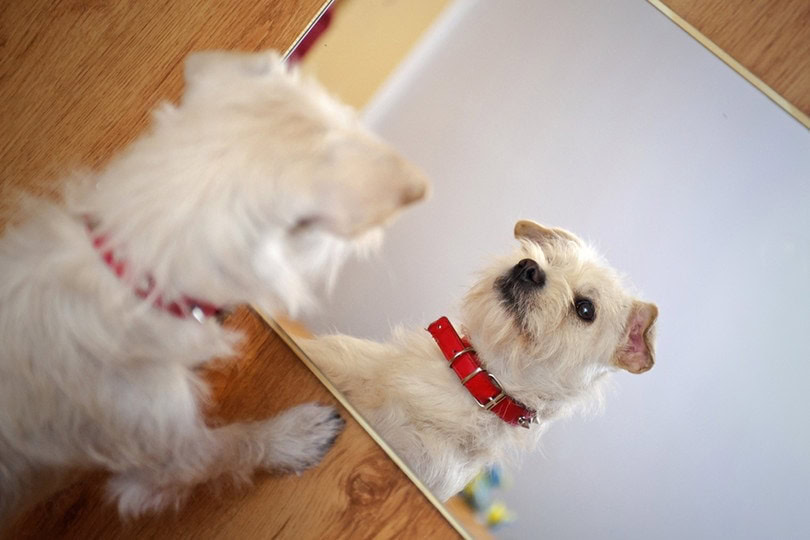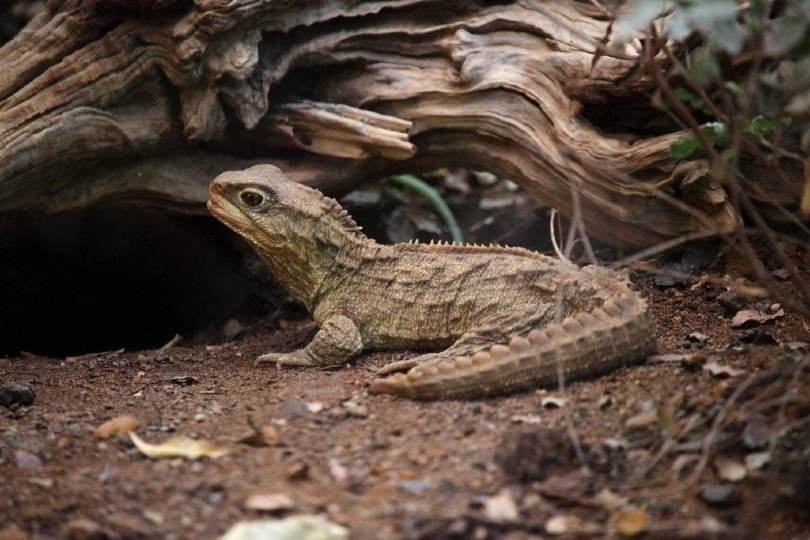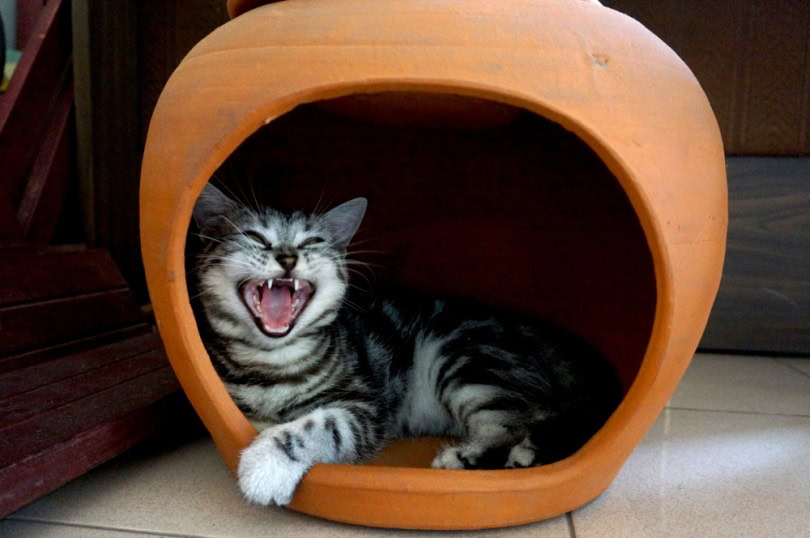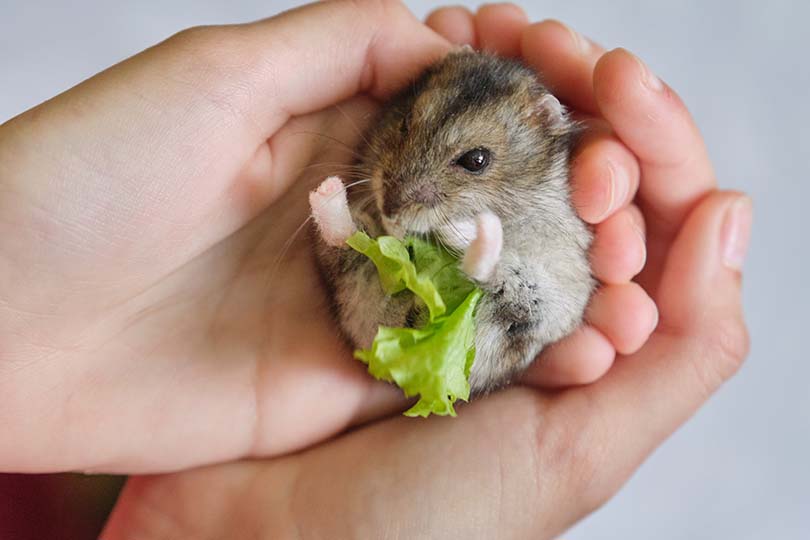VET APPROVED

The information is current and up-to-date in accordance with the latest veterinarian research.
Learn more »Click to Skip Ahead
When you witness a puppy experience a mirror for the first time, it can be an amusing and adorable sight. The puppy will go through a number of stages, the first one being awareness: they freeze for a moment upon spotting another dog. Then they become excited at finding a potential playmate and attempt to engage them and draw them into play. After a while, when they find they can’t interact with this strange new dog, they get bored and move on.
Most dogs do not inherently understand mirrors and may react to their reflection with curiosity, confusion, or indifference, as they lack the cognitive ability to recognize themselves in mirrors like some higher-order animals do. But does this mean that they don’t recognize the reflection as their own? And what about adult dogs, what do they perceive? Read on to delve into the psychological studies used to learn about dogs’ ability to understand mirrors.

The Mirror Test
Dogs have been a part of human society for tens of thousands of years, and throughout that time they have been prized for their intelligence and ability to learn and understand commands. But one question that has long puzzled dog owners and scientists alike is whether dogs understand mirrors and their own mirror image. The ability to recognize oneself in a mirror is a complex cognitive skill that is not shared by all animals. In fact, only a handful of species have been shown to have this capability, including humans, apes, dolphins, and elephants.
But what about dogs? Do they have the cognitive ability to recognize themselves in a mirror, or do they regard their reflection as just another dog?
To answer this question, researchers have conducted a number of studies on animals and mirrors. One of the most famous studies was designed by Gordon Gallup Jr. in 1970.1 Based on the premise that if an animal is self-aware, they will be able to recognize itself in a mirror, it involves placing an animal in front of a mirror and observing their behavior. If the animal is self-aware, they will use the mirror to investigate parts of their body that they cannot otherwise look at. This behavior is known as “self-directed behavior.” The mirror test has been used to study a wide range of animals, including chimpanzees, dolphins, elephants, magpies, and of course, our canine friends.
The mirror test has been criticized by some scientists for its limitations. For example, some animals may not show self-directed behavior in front of a mirror because they are not naturally curious about their own bodies. Despite these limitations, the mirror test remains an invaluable tool for studying animal behavior and cognition. It provides valuable insights into the self-awareness of different species and helps us better understand the complex ways in which animals perceive and interact with the world around them.
Do Dogs Pass the Mirror Test?
During the mirror test, a dog is placed in front of a mirror and observed for signs of self-recognition. This can include behaviors such as looking at the reflected image, touching the mirror, or trying to interact with the “other” dog in the mirror. If the dog shows signs of self-recognition, they are considered to have a level of self-awareness. Studies on dogs and the mirror test have produced mixed results, with most tests not able to demonstrate that dogs recognize themselves in the mirror. However, one study found that after a period of training dogs were able to recognize their reflections. Nonetheless, this does not necessarily mean that they understand the concept of a mirror image or have genuine self-awareness.
Habituation, where a dog gets used to something and learns a set response to a stimulus could also satisfactorily explain the results of this test. It is worth noting that the mirror test is not a definitive measure of self-recognition, and some researchers argue that it may not be an appropriate test for dogs due to their unique social and cognitive capacities.
We can say that when dogs look in a mirror, they do detect their reflection; they recognize a dog staring back at them, and this is obvious by the way they try to interact with the image. But unlike humans, it seems that dogs do not definitively recognize the image in the mirror as being themselves. Whereas humans, apes, dolphins, and even magpies can all pass the mirror test—dogs can’t: it may simply be that dogs lack visual representations of their bodies.

Dogs Smell Themselves
If a dog’s sense of self is not visual, then what is it? Scientists in Russia posited that because so much of a dog’s perception of the world comes through their nose that maybe a dog’s understanding of self is also derived from smell. Alexandra Horowitz, in a series of experiments in 2009, investigated dogs’ awareness of self through olfactory cues. This set of experiments had unambiguous results. They gave dogs a series of options about what to smell and how long to smell them. The choices were between their own urine, their own urine altered with another smell and the urine of other dogs.
Dogs showed the most enthusiasm, measured by time spent sniffing, for samples from other dogs, followed by less time smelling samples of their own altered urine, and the least to their own urine. This test shows that dogs have a strong concept of self when it comes to scent.
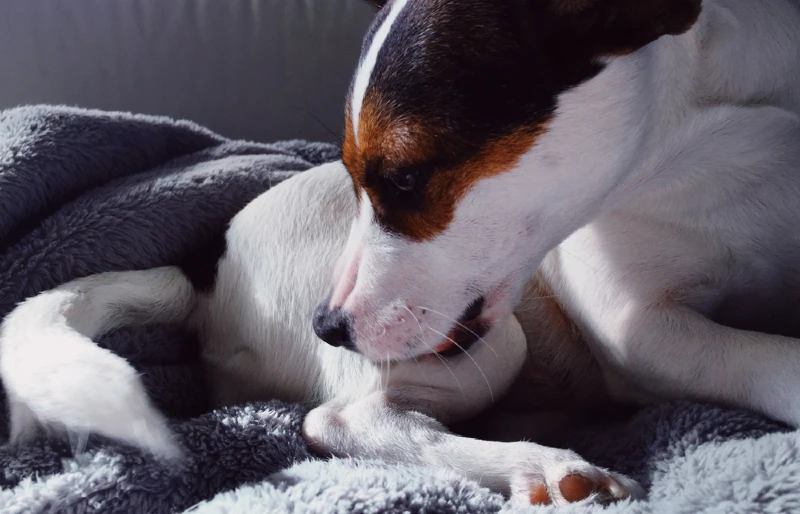

Conclusion
In conclusion, while there is still much we do not know about dogs and mirrors, it is evident that dogs do notice their reflections. However, they do not seem to have the same level of visual self-awareness as humans or other animals that have passed the mirror test. Dogs may be able to recognize themselves in a mirror after training, but it is still unclear whether they truly understand the concept of a mirror image or have accurate visual self-awareness.
While the mirror test may have its limitations, it remains an effective method for studying animal behavior and cognition. Further research on dogs and mirrors may help us better understand the unique way in which dogs perceive and interact with the world around them. Alternative studies suggest that dogs do have self-awareness or a concept of “self” based on their own scent rather than their look.
Featured Image Credit: Tomasz Wresien, Shutterstock
